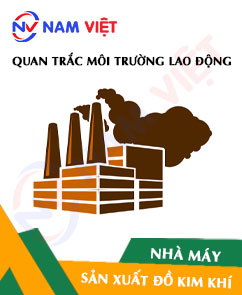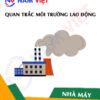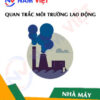Occupational Environment Monitoring at the Handheld Hardware Tools Manufacturing Factory
99,000 ₫
Note: The above price is calculated for one sample, and the price may fluctuate depending on the area of the environment to be monitored and market movements. For more accurate pricing support, please refer to the pricing table or contact our consulting staff directly.
Environmental monitoring of a hand-held hardware tools manufacturing factory is a session of collecting, analyzing, and evaluating workplace factors that may be harmful to workers’ health.
Table of Contents
Toggle1. Overview of Handheld Metal Tool Manufacturing Factory
a. What is a handheld metal tool manufacturing factory?
A manufacturing factory for handheld metal tools is a production facility specializing in small, hand-held metal tools used for cutting, chiseling, grinding, or marking on metal materials. These tools are commonly used in metal fabrication, repair, construction, mechanical processing, and various other industries.

b. Production processes in a handheld metal tool manufacturing factory
The main production processes in a handheld metal tool manufacturing factory include:
- Preparation of raw materials: Receiving and inspecting raw materials such as steel, alloys, and other components for use in production.
- Metal processing: Using tools and machinery such as lathes, milling machines, grinders, welding machines, and other processing methods to shape and manufacture the metal components of hand tools.
- Assembly: Arranging and assembling the processed metal components into complete tools.
- Quality inspection: Conducting quality checks on handheld tools through testing and verification methods.
- Packing and shipping: Packaging products into sets, boxes, or suitable packaging for shipment.

c. Machinery used in a handheld metal tool manufacturing factory
In a handheld metal tool manufacturing factory, various machines are used to process and produce metal tools. Some common machinery includes:
- Metal lathe: Used to process and shape metal parts on rotating shafts, allowing turning, grinding, drilling, and other operations on metal components.
- Metal milling machine: Used to process metal components using rotating cutting tools that move back and forth, allowing cutting and shaping surfaces and grooves on metal parts.
- Metal grinder: Used to grind metal surfaces and achieve precise shapes on components. There are various types, such as bench grinders, spindle grinders, and multi-purpose grinders, suitable for different processing stages.
- Welding machine: Used to weld metal components together. Types include electric welding machines, gas welding, MIG, TIG, and plasma welding, depending on product requirements.
- Metal cutting machine: Used to cut metal sheets into desired shapes and sizes. Types include plasma cutters, laser cutters, EDM wire cutters, and mechanical cutting machines.
- Metal bending machine: Used to bend metal parts into required curves or angles. Types include mechanical benders, pipe benders, and press brakes, depending on bending type and product size.
- Edge grinder: Used to grind and process edges of metal tools such as knives, scissors, wrenches, and other tools, sharpening cutting edges and ensuring high precision for components.

d. Occupational diseases for workers in a handheld metal tool manufacturing factory
Workers in handheld metal tool manufacturing factories may encounter the following occupational diseases:
- Neck and shoulder pain: Due to prolonged improper posture or using heavy or high-resistance tools, workers may suffer musculoskeletal issues such as neck pain, shoulder pain, and wrist arthritis.
- Joint diseases: Activities like hammering, chiseling, and grinding metal can damage joints, causing arthritis, joint degeneration, ligament inflammation, and sprains.
- Respiratory diseases: Metal processing can release grinding particles, metal dust, and welding fumes, which are hazardous to the respiratory system. Long-term exposure may lead to pneumonia, asthma, allergic rhinitis, and other respiratory issues.
- Skin diseases: Exposure to cleaning agents, solvents, chemicals, and metals can damage the skin. Workers may experience dermatitis, skin irritation, eczema, infections, and allergic reactions.
- Accidental injuries: Due to the nature of the work, accidents like cuts, punctures, impacts, or machinery-related injuries may occur.
To ensure safety and prevent occupational diseases, labor safety measures such as wearing personal protective equipment (e.g., masks, safety glasses), using protective gear (e.g., gloves, safety shoes), following safe work procedures, maintaining environmental hygiene, and providing safety training are essential.

e. Common handheld metal tools in the market
There are many types of handheld metal tools commonly available on the market. Examples include:
- Plasma cutter: Uses plasma to precisely cut metal materials.
- Grinder: Used to grind and polish metal surfaces.
- Drill: Used to drill holes in metal surfaces.
- Welding machine: Used to weld metal components together.
- Cutting pliers: Used to cut metal materials such as wires, cables, or metal rods.
- Metal saw: Used to saw and precisely cut metal materials.
- Crimping pliers: Used to crimp or press metal parts together or to cut wires and cables.
- Adjustable pliers: Used to twist, tighten, or loosen metal parts.
- Locking pliers: Used to clamp and hold metal parts securely.
- Wrench: Used to grip, cut, or turn metal components.
These are just a few examples of common handheld metal tools on the market. There are many other types depending on specific functions and applications in metalworking.
2. Overview of occupational environment monitoring services
a. What is occupational environment monitoring at a handheld metal tool manufacturing factory?
Occupational environment monitoring (or labor environment measurement) at a handheld metal tool manufacturing factory involves collecting, assessing, and analyzing measurable indicators of workplace environmental factors to implement timely measures, minimize environmental hazards to worker health, and prevent occupational diseases. Occupational environment monitoring is mandatory for handheld metal tool manufacturing factories.
This monitoring plays a critical role in caring for, protecting, and enhancing worker health, as employees are the primary resource of a business and directly generate its profits. Workers frequently exposed to risk factors exceeding permissible limits are affected health-wise and may develop occupational diseases.
REGISTER FOR OCCUPATIONAL ENVIRONMENT MONITORING SERVICE
b. Nam Viet’s occupational environment monitoring program
Nam Viet’s occupational environment monitoring program is designed by monitoring engineers specializing in labor safety and environmental protection. Aimed at ensuring worker health and safety, the program uses modern measurement methods to monitor air quality, water, microclimate, physical factors, dust, and other workplace environmental conditions. This program is crucial for maintaining a safe working environment and protecting employee health.
Additionally, Nam Viet’s program plays an important role in researching and developing new solutions to improve workplace environmental quality. With the dedication and professionalism of its monitoring experts, Nam Viet’s exclusive program has become a breakthrough in labor safety management and environmental protection in Vietnam.

c. Standardization in occupational environment measurement procedures
Standardization in Nam Viet’s occupational environment measurement procedures is crucial for ensuring the accuracy and reliability of results. The program follows recognized standards and procedures established by the Ho Chi Minh City Department of Health. This ensures that collected data can be reliably used to assess workplace conditions and guide improvements to protect worker health.
These standardized procedures also guarantee that measurements are conducted by highly qualified monitoring specialists with years of experience, allowing managers and experts to trust An Toàn Nam Việt’s results and make informed decisions to safeguard employee health and the environment.
By applying standardized procedures, Nam Viet demonstrates its commitment to ensuring a safe working environment, protecting worker health, and contributing to the development and enhancement of labor safety and environmental management in Vietnam.
d. Occupational environment monitoring report at handheld metal tool manufacturing factory
Occupational environment monitoring results are prepared according to Form No. 04, Appendix III issued with Decree 44/2016/ND-CP and are prepared in two copies: one sent to the contracting workplace and one retained by the monitoring organization.
The retention period for occupational environment monitoring results is indefinite according to legal regulations.

e. Frequency of occupational environment monitoring as required by law
According to Clause 2 of Article 18 of the Law on Occupational Safety and Hygiene 84/2015/QH13, employers must conduct occupational environment monitoring to assess harmful factors at least once per year.
f. Deadline for submitting occupational environment monitoring reports according to the law
The deadline for submitting reports is before December 31 each year. Enterprises operating production facilities must submit occupational environment monitoring results to the Department of Health at the locality where their headquarters and workers are located.
When there are changes in technology, production processes, or upgrades that may introduce new hazards to worker health, enterprises must update occupational hygiene records regarding harmful factors requiring monitoring.
g. Penalties for violations of occupational environment monitoring by employers
According to Article 27 of Decree No. 12/2022/ND-CP dated January 17, 2022, on administrative penalties in labor, social insurance, and Vietnamese workers working abroad under contract:
- Clause 2: Fines from VND 2,000,000 – 5,000,000 for employers who fail to publicly disclose monitoring results and hazard assessments to employees at the monitored workplace and the workplace under inspection immediately after obtaining monitoring results.
- Clause 3: Fines from VND 20,000,000 – 40,000,000 for employers who fail to conduct occupational environment monitoring to control impacts on worker health as required by law.
- Clause 4: Fines from VND 40,000,000 – 60,000,000 for employers who collude with monitoring organizations to commit fraud in occupational environment monitoring activities, but without reaching criminal liability.
3. Harmful environmental factors for workers in hand tool manufacturing factories
In hand tool manufacturing factories, there may be environmental hazards that pose risks to workers. Some potential harmful environmental factors include:
- Noise: Excessive noise from machinery and work processes can cause hearing problems and stress.
- Metal dust: Metalworking processes can generate fine metal dust, such as iron, aluminum, copper, and other alloys. Inhaling metal dust can harm the respiratory system and cause health issues.
- Chemicals: Chemicals used in the production, maintenance, and cleaning of hand tools can pose health hazards if not properly used or stored.
- Sparks and flames: During welding, metal cutting, or using power tools, there is a risk of fire and injury if safety measures are not followed.
- Fire and explosion: Flammable compounds and liquids such as oils, coolants, and other combustible substances can create fire and explosion hazards in the production environment.
- Lighting: Insufficient lighting or glare can affect vision and cause eye strain.
- Temperature: Working in excessively hot or cold environments can negatively impact health and create conditions for temperature-related illnesses.
REGISTER FOR OCCUPATIONAL ENVIRONMENTAL MONITORING SERVICE
4. Measures to improve the working environment in hand tool manufacturing factories
To improve the working environment in hand tool factories and ensure the health and safety of workers, the following measures can be applied:
- Ensure ventilation: Install effective ventilation systems to remove harmful dust and fumes. Adjust airflow and provide sufficient fresh air in the work area.
- Dust extraction: Use dust extraction or vacuum systems to remove metal dust and grinding particles from the air. Ensure regular maintenance and cleaning of the extraction system for optimal efficiency.
- Use personal protective equipment (PPE): Ensure workers properly use PPE such as masks, safety glasses, gloves, protective clothing, and safety shoes to guard against metal dust, chemicals, and other hazards.
- Training and education: Provide workers with training on occupational safety, proper use of tools and equipment, and awareness of potential workplace hazards.
- Equipment inspection and maintenance: Conduct regular inspections and maintenance of machinery and equipment to ensure safe and efficient operation. Repair or replace damaged equipment to prevent accidents.
- Waste management: Safely and legally manage waste and by-products from production. Implement proper sorting, recycling, and disposal methods to minimize environmental impact and health risks.
- Noise control: Apply soundproofing, reposition machinery, and adjust work processes to reduce noise. Ensure workers use hearing protection to safeguard their hearing.
- Temperature and lighting control: Maintain a comfortable working environment in terms of temperature and lighting. Adjust air conditioning and lighting systems appropriately to ensure worker comfort and safety.
- Periodically conduct occupational environmental monitoring in factories, collect and analyze harmful factors affecting workers, and adjust conditions to reduce hazards and prevent occupational diseases.
5. Benefits of periodic monitoring in hand tool manufacturing factories
An Toan Nam Viet provides businesses with excellent benefits when using occupational environmental monitoring services according to Decree 44/2016/ND – CP on managing and controlling harmful factors in the working environment affecting employees.
- Businesses can proactively control harmful factors in workshops or factories.
- Receive advice and recommendations on measures to reduce harmful factors and improve the quality of the working environment.
- Indirectly protect human resources, the key factor in business development.
- Reduce the impact of occupational diseases on health, thereby minimizing future medical treatment costs.
- Improved worker health leads to better product quality and stable production output.
- Ensure compliance with labor safety laws, avoiding legal risks.
- Enhance credibility and professionalism in all aspects, thereby elevating the company’s brand.
Nam Viet’s environmental monitoring service is a solution to minimize the impact of occupational diseases, contributing to a clean and high-quality working environment.

6. National occupational environmental monitoring center
Occupational Environmental Monitoring Center of Nam Viet is a professional unit for monitoring and measuring the quality of the working environment throughout all provinces and cities in Vietnam. With a team of experienced monitoring specialists, the center uses modern measuring equipment to ensure accuracy and reliability.
In addition to providing monitoring services, the center assists customers in planning, handling, and tracking occupational environmental issues. With the motto “customer-centered,” the center prioritizes customer satisfaction, meets all customer needs, and is committed to providing the best solutions for businesses.
REGISTER FOR OCCUPATIONAL ENVIRONMENTAL MONITORING SERVICE
With investments in technology, equipment, and human resources, Nam Viet’s monitoring center has become a reputable unit in the field of occupational environmental monitoring in Ho Chi Minh City with the following objectives:
- We always value brand reputation and the quality of our service products.
- We provide customers with the best and most suitable solutions possible.
- Together with a team of experienced Masters and Engineers, we aim to protect the environment and benefit businesses.
- By working with Nam Viet Environmental Monitoring team, companies receive professional services from experts and the best cost advantages.
The occupational environmental monitoring process at Nam Viet includes the following basic steps:
- Before conducting monitoring, our company ensures all machinery and equipment are adjusted and calibrated according to legal regulations.
- Strictly implement the occupational environmental monitoring procedures as committed to the Department of Health.
- Accurately report occupational environmental monitoring results to employers.
- If monitoring results indicate unsafe conditions for workers, Nam Viet will provide remedial solutions, and the employer will implement the following:
- Apply measures to improve working conditions to minimize harmful factors and prevent occupational diseases.
- Organize health checks to detect early occupational and work-related illnesses for employees in unsafe environments.
- Provide material compensation for employees according to labor laws.

7. Occupational environmental monitoring service quotation
To help businesses conduct occupational environmental monitoring professionally and effectively, Nam Viet provides customers with a high-quality and reasonably priced service quotation for occupational environmental monitoring.
- Our quotation provides detailed information on the costs of the monitoring services offered, including transportation, measurement, analysis, and reporting fees. Customers can be fully assured of the accuracy and reliability of the monitoring reports we provide.
- We commit to offering the most competitive and reasonable prices on the market and are always ready to promptly answer all questions regarding monitoring services professionally.
- With Nam Viet’s quotation, customers can easily choose service packages that meet their needs. We are committed to delivering the highest satisfaction with professional service quality.
No comments yet












Review Occupational Environment Monitoring at the Handheld Hardware Tools Manufacturing Factory
There are no reviews yet.